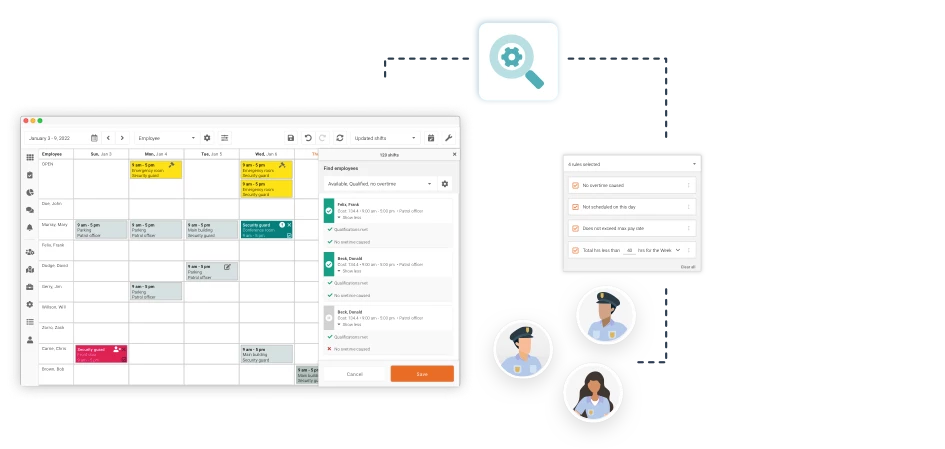Here at Celayix, we love to brag about how much money we can save you on overtime, just like that time we saved a company $100,000! However, eliminating overtime completely might not work for you! The fact of the matter is, there are so many variables around overtime, that it can be hard to determine if it’s the right choice or not. We want to take a look at the possible reasons you should use overtime, and how to manage that overtime effectively.
While most managers see overtime as a necessary evil, it doesn’t have to be that way. Managing overtime effectively does take a deep understanding of the impact it can have when abused. As we’ve broken down before, poor overtime management can:

- Negatively impact your bottom line
- Be detrimental to performance and productivity
- Cause burnout, stress and other health issues for employees
- Contribute to employee turnover
Of course, all of these scenarios are not ideals for any organization. However, just knowing that they are possibilities helps managers understand overtime better and manage it more effectively. When used properly, overtime can help businesses meet demand, minimize costs and keep employees happy.
When to use overtime
Depending on your industry, there might be some scenarios where overtime should be used, instead of the alternatives.
Round the clock coverage
A lot of industries require staff on the clock 24/7, like healthcare, manufacturing and security. While shift patterns may differ etc. it can often be difficult to fill the 168 hours in a week to provide 24/7 coverage. Before bringing employees into overtime, there are often gaps in coverage. Managers are then faced with 3 options to fill those gaps.
Hiring part-time employees: Yes, managers could simply hire a couple of part-time/flex employees to fill those gaps as and when they arise. However, finding and retaining strong part-time employees is challenging and time-consuming. Part-time roles also generally have much higher rates of turnover, which creates more costs for managers than overtime ever would.
Hire more employees: If managers want to avoid hiring and churning through part-time employees, they might just hire an extra full-time employee or two. Generally, in this situation, managers end up adding extra shifts to their schedule, in order to meet minimum hours for all employees. Adding extra shifts to the schedule adds to payroll costs, which again, is more than a couple of hours of overtime would have cost.
Use overtime: If it’s a case that there are less than 10 hours needed, the best solution would be to spread overtime across multiple employees. Yes, overtime requires you to pay your employees 1.5 time their hourly rate, but if it’s less than 10 hours, the above solutions simply don’t make sense. It might take some digging into the numbers to determine which option suits best.
Fluctuating Demand
In many industries, demand fluctuates at different points of the year. This fluctuating demand often creates periods of understaffing for companies. Of course, it will depend on your unique business needs, but it’s often the case that overtime is the most cost-effective solution to this problem. While some companies turn to temporary/seasonal workers, this is really only a solution for low-skilled workforces. Otherwise, there is a need for training etc. which creates cost for the company. These workers also don’t have the same company knowledge that regular, full-time employees would.
Using overtime to meet increased demand can work, assuming you are managing and monitoring burnout. Using overtime means you have zero training costs, and have a pool of experienced, familiar employees. These employees are likely going to be more productive and efficient than temp hires. Even though you pay a premium on the overtime they work, other costs such as employee benefits & vacations etc. remain stable. So, you’re avoiding training/lost productivity costs, and paying overtime which can be easily tracked and budgeted for.
Billable Overtime

In certain industries like security, overtime costs might be something you can bill to your client. Of course, this will depend on contracts and agreements. If your client requires a level of coverage that sends guards into overtime, passing the overtime costs on to them is by far the best option. As a scheduler, the responsibility falls on you to ensure other risks such as burnout and no-shows are addressed. In these industries, overtime is also often used as a way to attract talent. Security guards have notoriously low wage rates, which means that they often see overtime as a way to supplement their income. In these cases, offering overtime can be a great competitive advantage.
Managing Overtime Effectively
If you find yourself in any of the above scenarios, overtime is likely the best choice for your business. As we mentioned above, using overtime just because it makes sense does not mitigate the other common risks that come with it.
Monitor Overtime
If your organization is using it, one of the most important steps in effectively managing overtime is tracking and monitoring it. This means tracking overall overtime hours, as well as individual overtime hours. A great way to stay on top of overtime is to find your average weekly/monthly overtime needs. That way, if you go over that amount, you can review employee schedules and check in with employees. You can should also determine whether these increased levels of overtime are a one off event, or if they will occur for a number of weeks. Monitoring overtime is crucial to effective overtime management, and helps you adapt and adjust.
Track Absenteeism
Another important step in effectively managing overtime is keeping a close watch on rates of absenteeism. Similar to monitoring overtime hours, it is beneficial to monitor both individual absences as well as overall company absenteeism. This can help you spot patterns of behaviour in employees, or at particular times of the month/year. Understanding the reasons behind these absences is the key to success with overtime management. There will always be a certain level of legitimate absences, employees are human after all. Increased absences can be a result of burnout or other health issues that might be occurring from overtime. This can be a sign that overtime is not working for your organization and you should consider alternatives.
Overtime Policies
As with any other HR-related function, having a policy in place is part of effective overtime management. Having the policy in place is one thing, but frequently reviewing and revising it is equally important. As organizational needs change, so will overtime needs, and the policy should reflect that. There are a couple of areas that your overtime policy should address.
- Does your company have mandatory overtime requirements for employees?
- What criteria is used to determine who will be assigned overtime?
- Are there any loopholes/opportunities for employees to abuse the overtime process?
These are just a few of the important considerations for effectively managing overtime. Depending on your business and the industry you operate in, there may be other considerations. Being a part of a union might also impact your overtime management.
With all of this in mind, managing overtime effectively should be a huge priority for you as a business owner, manager or scheduler. While it might often be the best option for you, your employees should always be your first priority. Check-in with them regularly to ensure they are happy with the overtime processes, and to ensure they are healthy. If, however, overtime is an issue in your organization, Celayix truly can help you eliminate any unnecessary overtime from your schedule. If you’d like to hear more about how, reach out to a solutions advisor here!





